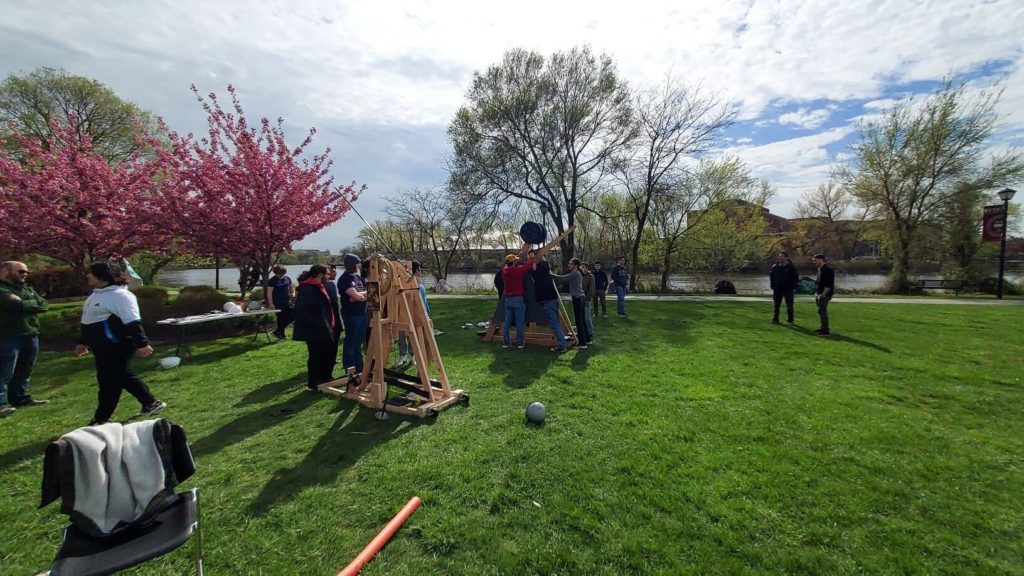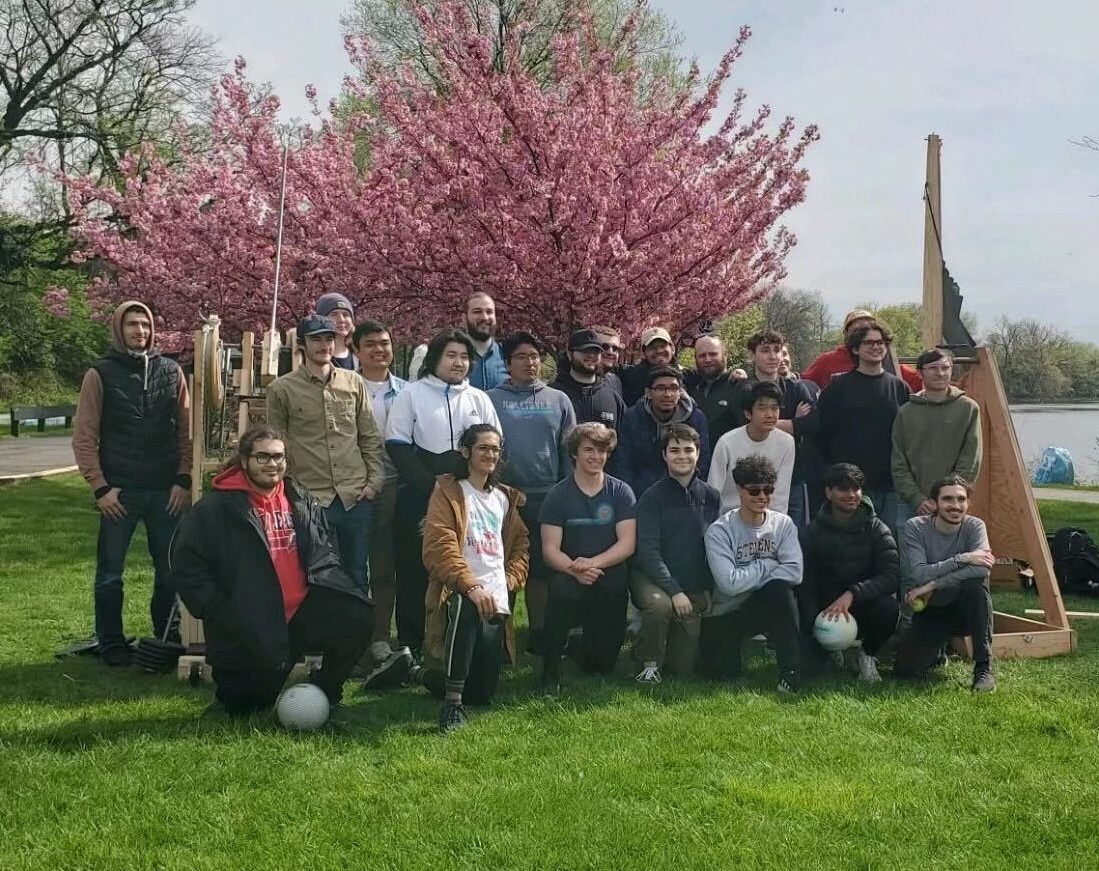

This past Friday, April 19, Stevens Institute of Technology made its debut at the annual American Society of Mechanical Engineers (ASME) Trebuchet Competition. Trebuchet team members Daniel Ahn, Francisco Arroyo Cruzat, Konnor Getz, Noah Golan, Logan Hickey, Cooper Kinsley, Krishna Mansukhani, Ryan Musantry, Cole Spitzner, Adrien Susino, and Thomas Wohlbruck made the trip to Hackensack, NJ to compete with Fairleigh Dickinson University team on their home turf.
Planning for the competition, formation of this 11-person team, and construction began back in the Fall 2023 semester. The team’s hard work during biweekly Monday and Thursday meetings, with some additional hours and love thrown in during the final weeks, produced Stevens’ very first trebuchet. When asked about his thoughts on the competition, Getz aptly shared, “It’s a medieval war machine, what’s not to love?”
For those not in the know, a trebuchet is a form of catapult utilized in ancient and medieval warfare characterized by a rotating arm with a sling attached to the end. Trebuchets were the top choice of artillery prior to the advent of gunpowder in the 9th century CE. There are multiple styles of trebuchets, but for the 2024 competition, the Stevens team opted for a whipper-inspired style characterized by the placement of the counterweight on top of the arm. When cocked, the arm of a whipper trebuchet is traditionally pointed in the direction the projectile will be launched in. Wohlbruck and Getz both mentioned that this type of design could be disconcerting to the onlooker. Getz shared, “It wasn’t something new, but it was something different. You would look at it and be like, ‘are you sure that’s right?’” Wohlbruck recalled thinking, “We gotta turn that around. We gotta do a 180.” Day of the competition, the Fairleigh Dickinson University (FDU) team had similar concerns. Getz recalled reaffirming the trebuchet was facing the correct direction.
When asked about the design, Getz informed that many of the calculations were based on design requirements outlined by the competition rules and regulations document, such as the 6’ by 6’ by 30” size regulation, and 150 lb weight regulation. “We knew what shape we wanted it to be, the whipping trebuchet design, so we just kind of figured a longer throwing arm would be best and calculated the maximum height from the restriction,” said Getz, who further shared that the design prioritized maximizing the gravitational potential energy while maintaining a center of mass ‘sweet spot’ so that the cocked arm would launch in the correct direction.
In the final days leading up to the April 19 competition, the team met on DeBaun field “thrice,” Wohlbruck reported. During the initial test launches, a tour group happened to be passing by. The prospective students congregated on the DeBaun field bleachers to watch the excitement unfold while Getz humorously recalls, “and we’re struggling. As soon as we fire it, it goes straight backwards.” Wohlbruck explained the team’s greatest tribulation to be the release of the trebuchet’s volleyball projectile. At the time, the team had not yet realized that the release was bending backward with each launch. “Once we had it supported in two places to prevent bending, it actually shot and we were so pumped–and then I ran over to Fluids,” referring to his Fluid Mechanics class. The design and construction of the trebuchet represent a significant undertaking, especially since the team members managed the workload alongside demanding academic responsibilities.
The trebuchet was delivered to the Fairleigh Dickinson Hackensack campus by Professor Yong Shi via U-Haul truck, while the team members split up between two cars. Aside from the team members, the competition was also attended by the two universities’ ASME chapter presidents, including Stevens’s Thomas Fallon.
Before the competition, troubleshooting and warm-up hours were scheduled for the day. The FDU team was approximately double the size of Stevens’s and had been around the block once before, debuting in the 2023 competition. Wohlbruck recalls that the FDU team opted for a more traditional trebuchet style, but it was by no means simple. Their arm was traditional, but the counterweight design stood out, utilizing a cam interface, separating the counterweights and the body.
During troubleshooting hours, the Stevens team was battling release mechanism troubles when the FDU team asked what they could help out with, explaining that they had that exact same issue last year and have since grown wiser. “They were super helpful and incredibly nice,” shared Wohlbruck, with Getz seconding. “They were extremely welcoming.” By the end of the competition, Getz reported the Stevens trebuchet was “working like clockwork,” thanks to the help of the FDU team and their provided replacement parts.
The competition consisted of three rounds in each of the four different counterweight categories: 60 lbs, 90 lbs, 120 lbs, and a bonus round. The bonus round is governed by the 150 lb design regulation. The trebuchet, sans weights, was required to be below 150 lbs, but for every lb below 150, the team may add that many lbs of counterweight, up to 30 lbs. While Stevens’ trebuchet, clocking in at 145 lbs, did not qualify to launch in this bonus round competition, the spirit of the competition had changed. Wohlbruck said, “At the end, we did away with the winning in general–with the whole ‘more points than the other.’” The Stevens team was slightly up in points, but this would not have been possible without FDU’s help with the replacement of the broken release mechanism parts and knot-tying expertise.
When asked if they have plans to return next year, Getz replied, “Yeah, definitely,” and Wohlbruck echoed, “Mmhm, we have things we want to change.” Wohlbruck provided insight that the team plans to build a totally new trebuchet next year, but it is still up in the air if the successor will be an iterative design of the 2024 version or a new style entirely, “It’s really what the people choose.” Next year, the competition hopes to garner more competitors, such as Rutgers or New Jersey Institute of Technology. Those interested in joining the team can contact Thomas Wohlbruck, Professor Yong Shi, or the new ASME E-board. Keep your eye open for the Mechanical Engineering Department-wide interest form email next fall!